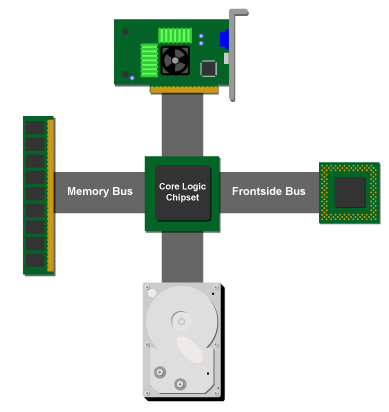Introduction
With the launch of Intel's 900-series chipsets and the recent return of SLI to the video card scene, PCI Express has finally arrived on the PC enthusiast scene in a big way. PCI Express-enabled motherboards are going to start becoming more and more common, and with the new bus's increasing ubiquity will come the inevitable confusion that accompanies the rise of any new technology, especially one as complex and feature-rich as PCI Express. In this article, we'll take a detailed look at the features of PCI Express ? what it is, what it isn't, and how it improves on the venerable interconnect scheme that we've all come to know and curse: PCI.
Basic PC system architecture
No doubt most Ars readers are familiar with the basic layout of a PC system, but it's worthwhile to do a brief recap in order to set the stage for the discussion that follows.
Logically, an average PCI system is laid out in something like the following manner:

Figure 1: PCI system layout
The core logic chipset acts as a switch or router, and routes I/O traffic among the different devices that make up the system.
In reality, the core logic chipset is split into two parts: the northbridge and the southbridge (or I/O bridge). This split is there for a couple of reasons, the most important of which is the fact that there are three types of devices that naturally work very closely together, and so they need to have faster access to each other: the CPU, the main memory, and the video card. In a modern system, the video card's GPU is functionally a second (or third) CPU, so it needs to share privileged access to main memory with the CPU(s). As a result, these three devices are all clustered together off of the northbridge.
The northbridge is tied to a secondary bridge, the southbridge, which routes traffic from the different I/O devices on the system: the hard drives, USB ports, Ethernet ports, etc. The traffic from these devices is routed through the southbridge to the northbridge and then on to the CPU and/or memory.

Figure 2: northbridge and southbridge
As is evident from the diagram above, the PCI bus is attached to the southbridge. This bus is usually the oldest, slowest bus in a modern system, and is the one most in need of an upgrade.
For now, the main thing that you should take away from the previous diagram is that the modern PC is a motley collection of specialized buses of different protocols and bandwidth capabilities. This mix of specialized buses designed to attach different types of hardware directly to the southbridge is something of a continuously evolving hack that has been gradually and collectively engineered by the PC industry as it tries to get around the limitations of the aging PCI bus. Because the PCI bus can't really cut it for things like Serial ATA, Firewire, etc., the trend has been to attach interfaces for both internal and external I/O directly to the southbridge. So today's southbridge is sort of the Swiss Army Knife of I/O switches, and thanks to Moore's Curves it has been able to keep adding functionality in the form of new interfaces that keep bandwidth-hungry devices from starving on the PCI bus.
In an ideal world, there would be one primary type of bus and one bus protocol that connects all of these different I/O devices ? including the video card/GPU ? to the CPU and main memory. Of course, this "one bus to rule them all" ideal is never, ever going to happen in the real world. It won't happen with PCI Express, and it won't happen with Infiniband (although it technically could happen with Infiniband if we threw away all of today's PC hardware and started over from scratch with a round of natively Infiniband-compliant devices).
Still, even though the utopian ideal of one bus and one bus protocol for every device will never be achieved, there has to be way bring some order to the chaos. Luckily for us, that way has finally arrived in the form of PCI Express (a.k.a. PCIe).
With Intel's recent launch of its 900-series chipsets and NVIDIA and ATI's announcements of PCI Express-compatible cards, PCIe will shortly begin cropping up in consumer systems. This article will give you the lowdown on what you can expect from the bus technology that will dominate the personal computer for the coming decade.
Note: A few of the more server-specific features of PCI Express are not covered in this article. These include hot plugging and hot swapping, as well as reliability-oriented features like packet retries and such.
reader comments
0